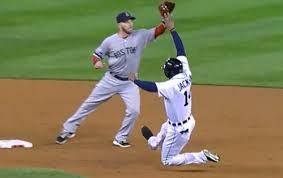Team A is looking to pull off a double play.
Team B is looking to disrupt said double play.
Team A's shortstop takes the toss from the second basemen, places his foot kind of/sort of near second base, and whips to first.
Out X 2.
This is, of course, the neighborhood play, which means the player does not actually have to step on second, but only has to be in the neighborhood of the base.
This allows middle infielders, as the New York Times put it in early May, "to protect themselves by getting out of the way of hard-charging runners."
The neighborhood play was initially feared to be going the way of letter-high strikes, posited Rob Neyer before the season started, thanks to the advent of video review. But it's not reviewable.
Back in 2009, Rich Garcia, Major League Baseball umpire supervisor, denied there was such a thing.
“There is no such thing as the neighborhood play,” he said. You either touch the base or you don’t.”
The New York Times says it's allowed, like pitchers and a spot of pine tar, as long as it's not too obvious. Stephen Drew was a little too obvious for the Red Sox during the American League Championship Series, though he did end up getting the out call.
“He wasn’t even in the neighborhood; he
was in a different county," former middle infielder Alex Cora told the Times.
Neighborhood play is not to be confused with a neighborhood play, such as when Spanky, Alfalfa, Darla and the gang would get together to stage a little song and dance.




